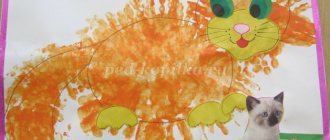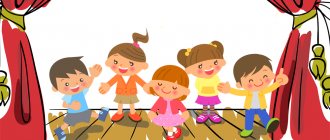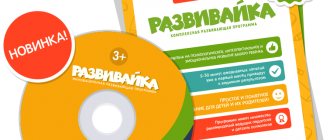Work program of the theatrical activities club in junior group 1
3. “Speech development” - children develop clear, clear diction, work is being done on the development of the articulatory apparatus using tongue twisters, tongue twisters, and nursery rhymes.
4. “Reading fiction” - children get acquainted with literary works that will form the basis for the upcoming production of the play.
5. “Cognitive development” - children get acquainted with the phenomena of social life, objects of the immediate environment, natural phenomena, which will serve as material included in the content of theatrical games and exercises.
Predicted results:
— development in children of cognitive activity, curiosity, desire for independent knowledge and reflection, development of mental abilities and speech;
— development in children, on the basis of various activities, of emotional responsiveness, the ability to empathize, and readiness to demonstrate a humane attitude in children’s activities, behavior, and actions;
- the ability to establish contacts, interact in different groups, and demonstrate a moral attitude towards the world around them.
- ability to play out excerpts from a work of art
- ability to imitate the image of heroes
- ability to work in a team
Subject of the lesson Purpose Equipment
October
1.I. “Okay, okay, grandma was baking pancakes.”
II. “Cook, cook, porridge...”
(let’s treat grandma)
Activate fine motor skills of the hands, establish a connection between speech and motor functions.
Instill interest in a puppet show and develop the ability to concentrate attention on a puppet. Puppet theater
2.I. "Goat Trouble"
II. "The horned goat is coming"
Accustom children to listen to songs performed by a teacher while watching the actions of tabletop
theater toys Bibabo Theater (goat)
.
3.I. "Ryaba Hen"
II. "Gifts from the Ryaba Chicken"
Teach children to listen carefully to a fairy tale, watching the actions of the teacher with pictures on a flannelograph Flannelograph, noisemaker eggs
4.I. "Bird"
II. "Duck and Ducklings"
Introduce children to the nursery rhyme, teach them to listen to the text, repeat the movements of an adult, involve children in controlling the toy Finger
theater
, duck cap
November
1.I. "Happy Geese"
II. Outdoor game "Geese-geese"
Introduce children to the performance, encourage children to react emotionally to the actions taking place Tabletop
theater
2.I. "Teddy bear"
II. Outdoor game "Teddy Bear"
Encourage children to follow with interest the actions of the teacher with a soft toy, support the desire to communicate with the toy, and develop emotional responsiveness. Toy
3.I. "Golden Comb Cockerel"
II. “The chicken went out for a walk”
(song improvisation)
To create a desire to participate in
theatrical and play activities
, to introduce children to games using caps and masks. Caps and masks for dramatization, a toy cockerel.
Card index of theatrical games in the first junior group. card index (junior group)
Card index of theatrical games in the first junior group
Explanatory note
Theatrical play is an effective means of social-personal, cognitive-speech and artistic-aesthetic development of a preschooler. The development of theatrical play in preschoolers is more effective with a special organization of the pedagogical process.
This becomes possible if the teacher gradually reorients the child from the process of the game to its result. The path to development of play is joint play between an adult and a child, the creation of an enriched play environment that encourages independent play creativity in free interaction with toys and peers. Play as part of the educational field “Socialization” is integrated with all educational fields, since it is the main form of implementation of various types of children's activities, including organized educational activities, a method of educating and developing younger preschoolers, and a form of organizing the lives of children in kindergarten.
“The turnip grew big and big”
Russian folktale
Tasks:
Read a fairy tale to the children.
To teach listening to a story using a visual image of staged fairy tales on flannelgraph.
Game-situation “In our yard” To evoke positive emotions in children;
Enrich the experience; awaken interest in the game, the desire to imitate the intonation of an adult’s voice.
The BI-BA-BO puppet theater and flannelgraph are used
A. Barto “Toys”
Tasks:
Introduce poems.
Teach children to perform characteristic actions when reading again, repeating lines of text after the teacher
To develop the ability to convey basic emotions through facial expressions, gestures, and movements.
Encourage children's willingness to participate.
Used tabletop theater toys
Fairy tale "Kolobok"
Tasks:
Arouse interest in theatrical play through the first experience of communicating with characters.
Invite children to follow the development of the plot based on illustrations,
Develop attention and visual - effective thinking;
Learn to name characters and their actions. Reinforce in speech the names of animals and their characteristics; expand the active vocabulary: round, ruddy, red and cunning, clubfoot, etc.
Theatrical game based on a fairy tale (the theater on spoons, Bi-Ba-Bo is used;)
Nursery rhyme “Cucumber, cucumber...”
Cucumber, cucumber,
Don't go to that end
There's a mouse living there
He'll bite your tail off!
Tasks:
Teach children to pronounce a nursery rhyme. Mastering affectionate behavior (cucumber, ponytail, mouse).
Develop attention, enrich vocabulary.
Cultivate careful behavior.
Option 2. Use in a game (the mouse lives there - the children run away
Theatrical nursery rhyme game (head masks are used)
Folk game: “The gray bunny is sitting”
Tasks:
Improve the ability to examine objects, learn to examine, feel;
Learn to perform movements as shown by the teacher and pronounce the words of the song
Develop emotional responsiveness, the desire to communicate with peers, play together;
Game - the situation “The girl forgot to feed the kitten, he couldn’t remember how to ask for food.”
Tasks:
Learn to identify yourself with a theatrical character; develop mindfulness;
Learn to combine movements and speech; consolidate knowledge about the environment.
The game is the situation “For the grandfather, for the woman, the Ryaba Hen laid a golden egg.”
Tasks
Stimulate children's emotional perception of theatrical play and active participation in it;
Develop children's physical activity. Retelling a fairy tale with movements.
Strengthen the ability to imitate movements
Theatrical play based on a fairy tale, all types of theater are used
“We won’t tell you where we were, but we’ll show you what we did.”
Objectives: Encourage children's attempts to participate in a collective conversation and make joint decisions; develop creative imagination; encourage children to improvise.
Using a counting rhyme, the driver is selected. He leaves the room. Children agree on what and how they will portray. The driver returns and asks: “Where have you been, boys and girls? What did you do?" The children answer: “We won’t tell you where we were, but we’ll show you what we did.”
Children show the actions they came up with.
During the game, the teacher first advises what and how to depict. When the children get used to it, he only suggests what to depict, and how to do it, they decide for themselves
Fairy tale "Kids and the Wolf"
Tasks:
Introduce children to the work, teach them to follow the development of the plot based on illustrations. During special moments
Game "Bunnies for a walk"
Tasks:
Teach children to perform playful actions and engage in play with peers.
To develop the ability to perform basic role-playing actions. Game situation using various attributes (table theater). Circle theater, etc.)
Tasks (children hold “bi-ba-bo” dolls or ordinary toys in their hands).
1. The dolls meet each other and:
a) say hello
b) ask each other about health,
c) say goodbye.
2. One doll accidentally pushed the other. We must ask for forgiveness and, accordingly, apologize.
3. The doll is celebrating her birthday. Her friends come to her and:
a) congratulate you on your birthday and give gifts.
b) the doll thanks for the congratulations and invites you to the table.
c) one of the guests was late: ask for forgiveness for being late.
d) one of the guests accidentally spilled compote on the tablecloth, play out the actions of the hosts and the offender.
3. Some tasks can be offered to children to complete without dolls:
a) knock, go into the group and call one of the children with a gesture (silently, so as not to interrupt the teacher’s story);
b) go to the head (methodologist, speech therapist, etc.) and give her a message;
c) explain to “mom” why clothes are dirty after visiting kindergarten;
d) apologize to the children for the fact that the ball rolled and broke the sand buildings.
ORGANIZATION OF THEATER ACTIVITIES WITH CHILDREN IN THE THIRD YEAR OF LIFE
Kovaleva Natalya Nikolaevna Podkopaeva Irina Ivanovna educators Tuma Irina Aleksandrovna teacher of additional education MBDOU DS No. 62 “Golden Beehive” Starooskolsky urban district
ORGANIZATION OF THEATER ACTIVITIES WITH CHILDREN IN THE THIRD YEAR OF LIFE
The federal state educational standard for preschool education is aimed at solving various problems, one of which is the development of the child’s abilities and creative potential . It is in preschool age that the foundations development and creative abilities .
Theatrical activities in kindergarten are a good opportunity to reveal the creative potential of the child and nurture the creative orientation of the individual.
Since creative personality traits begin to appear at an early age, we believe that it is very important not to miss this period and begin introducing children to theatrical activities in the first junior group.
We carry out work on the formation of a creative personality through the development of theatrical activities in the first junior group in several stages.
Advertising message
The first stage takes place during the period of children’s adaptation to the conditions of kindergarten. We use the technique of greeting children in the morning with the Parsley doll, which helps to establish friendly relations between teachers and children. The use of dolls and “doll conversations” helps relieve mental stress and shift the child’s attention from his own experiences to a new object – a doll. A folk toy “tells” nursery rhymes, folk songs, and fairy tales to children, and develops children’s desire to make contact, play with peers, and share toys.
To form initial ideas about the theater, we organize viewings of performances prepared by pupils of senior preschool groups. We begin introducing children to theater with the simplest form that is accessible to a child’s emotional response – puppet theater. In order for the kids to be able to grasp the meaning of the events taking place on stage, shortly before the start of the performance we tell them about the content of the performance. During the performance itself, we connect the children’s attention to the events taking place on stage. During these spectacles, children learn to watch and understand what is happening, express their emotions, and react to the positive and negative actions of the characters.
We constantly use the technique of theatricalization in the form of game educational situations in direct educational activities. Theatrical characters interact with children and perform various actions, which increases cognitive activity and promotes the development of creative skills.
We assign a large role to individual work, taking into account that children have different levels of development and poorly developed joint activity skills. Since it is easier for a child to show than to tell, we base our work on the use of imitative, imitative movements. At the same time, we use various forms of work. So, when waking up children after a nap, we suggest “depicting” how the ducklings wake up, stretch, flapping their wings, etc. We do morning exercises by playing out scenes from familiar fairy tales. Characters from the bi-ba-bo theater and glove puppets participate in the outdoor games.
Having analyzed the results of activities with children at the first stage, concluding that the work carried out contributed to the favorable adaptation of children to kindergarten and the maintenance of the emotional state of children, we move on to the next stage of work.
When children are accustomed to joint activities and communication, we use elements of role-playing theatrical play. In it, we follow the principles of gender education: girls in the play corner, first with the help of teachers, and then independently organize games in which, imitating adults, they talk to dolls, put them to bed, feed them, and wash them. Boys ride dolls in cars, build houses for them, and do shopping.
The theatrical games we use include elements of dramatization, which are based on the corresponding actions of the role player. When playing together with adults, children reproduce actions characteristic of the character and show good feelings towards toys. We develop in children the ability to display everyday actions in a role-playing theatrical game based on the children’s ideas about family relationships.
In order to educate children such qualities as sincerity, kindness, responsiveness and others, we use games - dramatizations based on familiar fairy tales.
We conduct simulation games in which we invite children to imitate the actions of people, animals and birds. In games that imitate the images of well-known fairy-tale characters, children depict how animals from the fairy tales “Teremok”, “Kolobok” move and speak, like “Birds are flying”, “The Bunny is jumping”, “The Bear is coming to visit”. Thanks to this, children develop imagination and freedom of imagination.
Once a month, we conduct direct educational activities on artistic and aesthetic development (acquaintance with fiction) entirely as a theatrical activity. A work of art presented to children of primary preschool age in the form of a theatrical production is absorbed and remembered much better. We offer children performances with a simple, clear and funny plot, familiar characters and a happy ending.
In the process of conducting didactic games “Find a pair”, “Guess who lives in which fairy tale”, “Who is hiding?” we use three-dimensional characters from tabletop, finger and other theaters.
Noting the positive dynamics in the development of theatrical activities, we came to the conclusion that children have accumulated experience in displaying the surrounding reality in the game. They began to show emotional responsiveness, engage in concrete actions of help, care, and participation.
Based on these findings, we move on to stage 3.
To develop skills in theatrical activities, we use role-playing reading of simple poems and nursery rhymes, accompanied by a demonstration of finger or table theater. We select folklore works that are figurative, understandable to children, and always contain dialogue: “Kitsonka-Murysonka”, “Vanka-Vstanka”.
Then, together with the children, we stage individual scenes and short, simple works. To master these skills, in individual work we provide children with the opportunity to play contrasting roles - an old bear and a little bear cub, an angry dog and a defenseless puppy. By playing out a number of poems and nursery rhymes with children, we encourage them to combine words and movements. Taking into account the age characteristics of children, the fact that children “think with their hands”: they do not so much think as act directly, we give the kids the opportunity to play with the theater figures themselves.
Next we move on to the theatricalization of a specific work. To do this, we plan and carry out a whole range of events: for example, to stage the fairy tale “Kolobok”, we invite children during morning exercises to convey in motion how the Teddy Bear, the Hare, and the Fox walk through the forest. In the process of organized activities for the development of speech, we train children in the dialogue between an old man and an old woman, Kolobok and Bunny. In the course of organized activities for artistic and aesthetic development (musical activity), we train children in singing the Kolobok song, learn the Bunny dance, etc.
Theatrical activities began to occupy an important place in the pedagogical process of the first junior group, contributing to the comprehensive creative development of children.
*******
This material was presented at the regional scientific and practical conference “FORMATION OF THE CREATIVE PERSONALITY OF A PRESCHOOL CHILD THROUGH THEATERIC ACTIVITIES”





